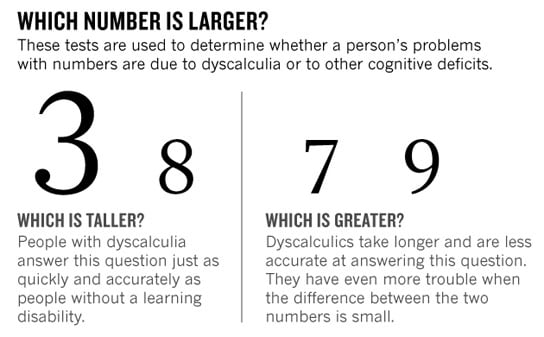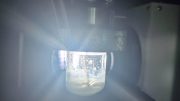
Dyscalculia, also known as “number blindness,” is a learning disability similar to dyslexia, but for numbers. Credit: Nature 150–153, (10 January 2013), doi:10.1038/493150a
Dyscalculia is a learning disability, which is sometimes called number blindness, and similar to dyslexia, but for numbers. Researchers estimate that as much as 7% of the population has dyscalculia, which can be marked by severe difficulties in dealing with numbers despite otherwise normal intelligence.
Neuroscientists believe that the disorder illuminates the inner workings of the human brain and its innate number sense. The sense is as innate as vision or hearing, yet scientists disagree over its cognitive and neural basis.
Brain Butterworth, a neuroscientist, is hoping to develop treatments for dyscalculia using learning software. If dyscalculia is a deficiency of basic number sense and not memory, attention, or language, then fostering the roots of the number sense could help dyscalculics. A classic sign of dyscalculia is a difficulty in grasping the place-value system.
Early research led Butterworth to believe that numerical abilities relied on specialized brain networks. Brain scans of an early dyscalculic patient revealed lesions in the parietal lobe. But another patient with the opposite pattern of disability, neurodegeneration that robbed him of speech, language, and knowledge, still managed to do intricate calculations. These findings strengthened Butterworth’s belief that numerical abilities relied on specialized brain networks, and not only on those supporting general intelligence, as many scientists believed at the time.
Number sense is evolutionarily ancient in humans, tens if not hundreds of millions of years old. Studies of chimpanzees, monkeys, newborn chicks, salamanders, and honeybees point to two parallel systems for representing quantities. The first one called the approximate number sense, distinguishes between larger and smaller quantities. The second one allows humans and some animals to instantly and precisely recognize small quantities of up to four.
People who are poor at distinguishing approximate quantities do badly in math, indicating that the approximate-number system is crucial. Dyscalculics are poor at recognizing small numbers, indicating that this ability is also fundamental for numeracy. Brain scans of dyscalculics suggest that the intraparietal sulci are less active when processing numbers and less connected with the rest of the brain.
Other neuroscientists think that approximation and a sense of small numbers, while critical, aren’t enough for humans to precisely grasp large numbers. They argue that language allows people to integrate the two systems, giving them the ability to intuitively distinguish two similar numbers, like 11,478 and 11,479.
Researchers note that dyslexia, ADHD, and autism spectrum disorder are common among dyscalculics, and it can prove difficult to untangle these problems.
Reference: “Dyscalculia: Number games” by Ewen Callaway, 9 January 2013, Nature.
DOI: 10.1038/493150a









Dyscalculia is discussed, from time to time, at:
The ADHD Bulletin Board:
http//health.groups.yahoo.com/group/ADHD_Bulletin_Board/
As you may or may not be aware of, some of the stimulants/alerting agents used to temporarily reduce ADHD have been called arithmetic pills since the FDA approved pills, for some, temporarily improve aspects of math ability for some users.
Thank you for your article about Dyscalculia. Appreciate it.